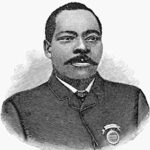This Day in History: 1856-04-23
 Prolific inventor Granville Tailer Woods, who held more than 60 patents in the U.S., is born. He was the first African American mechanical and electrical engineer after the Civil War. Self-taught, he concentrated most of his work on trains and streetcars. One of his notable inventions was a device he called the Synchronous Multiplex Railway Telegraph, a variation of induction telegraph which relied on ambient static electricity from existing telegraph lines to send messages between train stations and moving trains. His work assured a safer and better public transportation system for the cities of the United States. Woods was described as an articulate and well-spoken man, as meticulous and stylish in his choice of clothing, and as a man who preferred to dress in black. At times, he would refer to himself as an immigrant from Australia, in the belief that he would be given more respect if people thought he was from a foreign country, as opposed to being an African American. Black newspapers of the day expressed pride in his achievements, saying he was “the greatest of Negro inventors”. In 1887, Woods patented the Synchronous Multiplex Railway Telegraph which allowed communications between train stations from moving trains by creating a magnetic field around a coiled wire under the train. Woods caught smallpox prior to patenting the technology and Lucius Phelps patented it in 1884. In 1887, Woods used notes, sketches and a working model of the invention to secure the patent. The invention was so successful that Woods began the Woods Electric Company in Cincinnati, Ohio to market and sell his patents. However, the company quickly became devoted to invention creation until it dissolved in 1893. Thomas Edison later filed a claim to the ownership of this patent, stating that he had first created a similar telegraph and that he was entitled to the patent for the device, and Woods often had difficulties in enjoying his success as other inventors made claims to his devices. Woods was twice successful in defending himself, proving that there were no other devices upon which he could have depended or relied upon to make his device. After Thomas Edison’s second defeat, he decided to offer Granville Woods a position with the Edison Company, but Granville declined. Learn more.
Prolific inventor Granville Tailer Woods, who held more than 60 patents in the U.S., is born. He was the first African American mechanical and electrical engineer after the Civil War. Self-taught, he concentrated most of his work on trains and streetcars. One of his notable inventions was a device he called the Synchronous Multiplex Railway Telegraph, a variation of induction telegraph which relied on ambient static electricity from existing telegraph lines to send messages between train stations and moving trains. His work assured a safer and better public transportation system for the cities of the United States. Woods was described as an articulate and well-spoken man, as meticulous and stylish in his choice of clothing, and as a man who preferred to dress in black. At times, he would refer to himself as an immigrant from Australia, in the belief that he would be given more respect if people thought he was from a foreign country, as opposed to being an African American. Black newspapers of the day expressed pride in his achievements, saying he was “the greatest of Negro inventors”. In 1887, Woods patented the Synchronous Multiplex Railway Telegraph which allowed communications between train stations from moving trains by creating a magnetic field around a coiled wire under the train. Woods caught smallpox prior to patenting the technology and Lucius Phelps patented it in 1884. In 1887, Woods used notes, sketches and a working model of the invention to secure the patent. The invention was so successful that Woods began the Woods Electric Company in Cincinnati, Ohio to market and sell his patents. However, the company quickly became devoted to invention creation until it dissolved in 1893. Thomas Edison later filed a claim to the ownership of this patent, stating that he had first created a similar telegraph and that he was entitled to the patent for the device, and Woods often had difficulties in enjoying his success as other inventors made claims to his devices. Woods was twice successful in defending himself, proving that there were no other devices upon which he could have depended or relied upon to make his device. After Thomas Edison’s second defeat, he decided to offer Granville Woods a position with the Edison Company, but Granville declined. Learn more.
